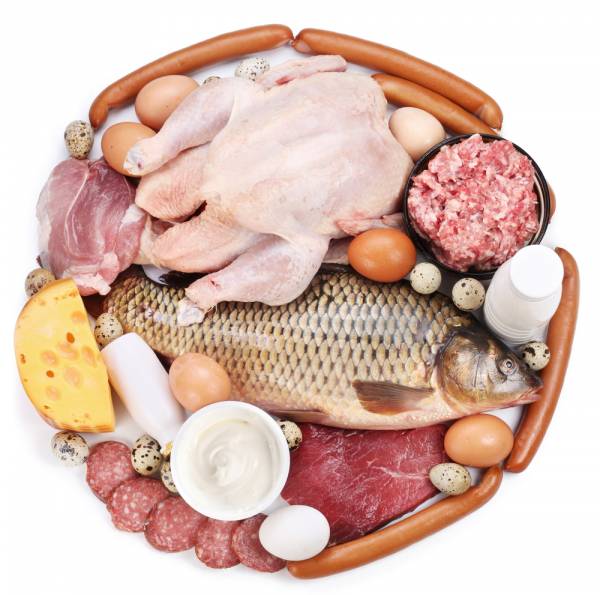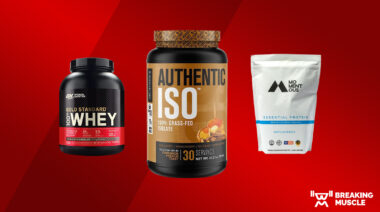Over the past gazillion years, it has been one of the most beat-to-death questions: How much protein do I need to build muscle?
Most male teenagers and adults – and now females in the iron game – fervently seek the answer. The conventional view naturally leads to the notion that consuming more must be better, if more muscle mass is the goal (Super-Size Me!). Yes, one needs the macronutrient protein to build muscle, but exactly how much?
Over the past gazillion years, it has been one of the most beat-to-death questions: How much protein do I need to build muscle?
Most male teenagers and adults – and now females in the iron game – fervently seek the answer. The conventional view naturally leads to the notion that consuming more must be better, if more muscle mass is the goal (Super-Size Me!). Yes, one needs the macronutrient protein to build muscle, but exactly how much?
A research study published in the Journal of the American Medical Association produced a report by the Board of the Institute of Medicine to determine optimal intake of the macronutrients protein, carbohydrates, and fats.
Regarding protein intake, they determined the recommended daily allowance (RDA) for those 18 years of age and older was 0.8 g of protein per kilogram body weight per day. In plain English, this means .36 grams per pound of body weight.
It was also noted the dietary guidelines published by the U.S. Department of Agriculture and Governmental programs, such as the school lunch program for children and Meals on Wheels for elderly persons, use the .36 grams/pound/day as well.
Same for dietary guidelines published in the dietetic literature, the popular press, and various nutritional computer programs – a recommend protein intake of .36 grams/pound/day.
In example, a 190 pound person would need only 68.4 grams of protein per day. That requirement could be met by ingesting a 4 ounce skinless chicken breast, half a cup of low-fat cottage cheese, and half a cup of crushed walnuts in one day.
Huh? That’s it for protein? Only .36 grams per pound each day? More on the study:
The RDA for protein was based on the results of all available studies that estimated the minimum protein intake required to avoid progressive loss of lean body mass as reflected by nitrogen balance.
The Food and Nutrition Board admitted that relying solely on results from nitrogen balance studies to determine the RDA did have limitations, because this method does not measure any relevant physiological end point.
Additionally, the existing data were gathered almost exclusively in college-aged men and a greater nitrogen intake was likely required to maintain nitrogen balance in elderly persons.
Regardless of whether .36 grams/pound/day is an appropriate value for the RDA for elderly persons as well as for individuals 18- to 50-years-old, the point is the RDA is functionally defined as the amount of protein needed to avoid a deficiency that would lead to a progressive loss of lean body mass (as reflected by negative nitrogen balance).
The Acceptable Macronutrient Distribution Range (AMDR) of protein was noted to be between 10% and 35% of the daily energy intake (DRI).
For example, the daily energy requirement of a sedentary 19-year-old reference man (5’-9” tall and 167 pounds) is estimated to be 17.2 total calories per pound (2,872 total calories/day).
Ten percent of this caloric intake as protein would equal .43 grams/pound/day (72 grams) and 35% would equal 1.5 grams/pound/day (250 grams!). Thus, the RDA is below the lowest intake recommended by the AMDR when considered in the context of the overall dietary intake of macronutrients.
This discussion is relevant to nutrition policy only if there is evidence the optimal level of protein intake differs from the minimal requirement. The wide range recommended in the AMDR (10%-35% of energy intake) implies uncertainty regarding the exact optimal level of protein intake.

This uncertainty reflects in part a relative lack of research addressing this issue. In addition, the wide range reflects, by deduction, uncertainty regarding the optimal levels of carbohydrate and fat in the diet.
The problem of widespread misinterpretation and improper application of the RDA arises from the fact the Food and Nutrition Board maintained the historically familiar term “recommended dietary allowance,” but functionally defined it in terms misunderstood by most individuals.
The distinction is that a requirement clearly defines the minimum amount needed, whereas no such implication is conveyed with the any recommendations.
These points notwithstanding, there is ample evidence the optimal level of protein intake is greater than the RDA.
A variety of studies have shown levels of protein intake above the RDA benefiting muscle mass, strength, bone health, maintenance of energy balance, cardiovascular function, and wound healing.
Close examination of these and related research studies should enable a reasonable estimation of the optimal level of protein intake in a variety of circumstances.
It was concluded there was no evidence documenting an upper level of protein intake beyond which adverse effects would ensue. Consequently, the DRI indicated there is no tolerable upper intake level for protein.
Well, there you have it. After sifting through all the murky data and interpretations, we know THE MINIMUM amount of protein required to avoid losing muscle mass is around .36 grams/pound of body weight per day needed for growth and repair of muscles, bone, tendons, skin, hair, and other tissues.
But we are talking about inactive, non-athletic humans here. Of course these individuals would require less than an active trainee/athlete.
What if you’re an avid strength-trainer? What if an endurance or sport-playing athlete? The daily menu of intense, energy-depleting training components such as lifting, running, and practicing, taxes the skeletal-muscle system way beyond the average sedentary Jane and Joe.
Will .36 grams/pound/day of protein be enough for growth and repair? NO!
Athletes, strength-trainers, endurance athletes and other ACTIVE people need more protein due to the simple fact their bodies are being “abused.”
The MINIMUM amount of protein for athletes should be at least .55 grams/pound/day.
Depending upon your sport or training regimen, the daily requirement can go as high as .9 to 1 grams/pound. To determine a reasonable estimate of your daily protein needs, use this calculator that factors in your age, height, weight, activity level, and training goals.
Protein intake simplified
- If you’re an avid athlete/trainee, you need more than the consensus of .36 grams/pound/day (.55 to 1 gram/pound/day). Use the on-line calculator that offers a reasonable estimate of your daily needs.
- Divide the total estimate by the number of meals you consume each day. Try to eat that amount at each meal.






